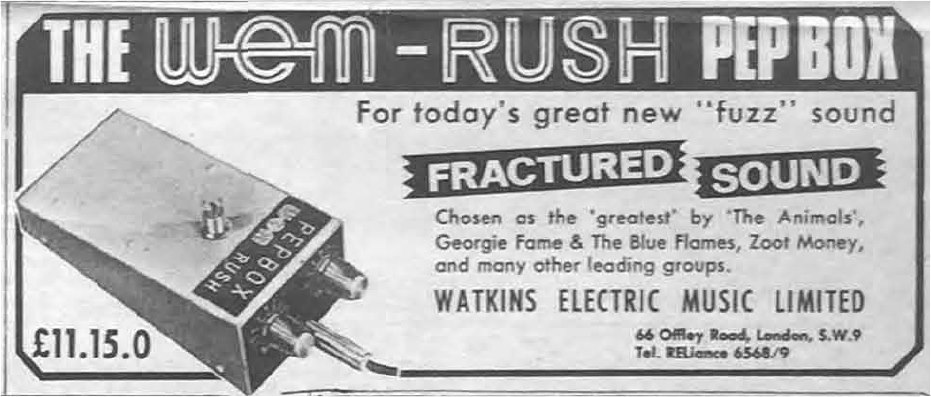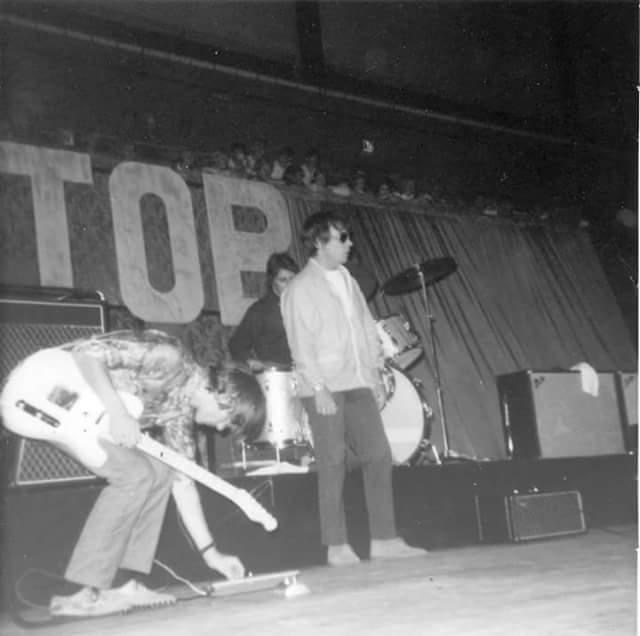History
During the 1960s, Pepe Rush ran a recording studio on Berwick Street in Soho, London. Pepe also had a workshop in a nearby mews, and this was presumably where much of the ‘Rush Electronics’ studio equipment was built, including the various guitar & bass amplifiers and effects units.
Early Pep Boxes were reportedly sold by Rush directly to musicians.1 Later on, Pepe Rush partnered up with Charlie Watkins, and the pedals were marketed & sold under the WEM brand.
It is not known at what point Rush began building fuzz boxes, but by August 1965 he was already involved with WEM, because the Pep Box was demonstrated by WEM at the British Musical Instrument Industries Trade Fair of that year.2 An early version of the Pep Box was pictured and advertised in Melody Maker, at various times in early 1966.
No examples of the Pep Box, built before Rush’s partnership with WEM, are known to have survived. A common misconception is that the red ‘Fuzzy’ pedals, featuring a ‘pep’ control, were early versions of the Pep Box. The red ‘Fuzzy’ pedals appear to have been built in Germany, which is where they tend to resurface, and the date codes on the components in these pedals confirm that the model was only built following the WEM Rush ‘silver wedge’ era of Pep Boxes. Pepe Rush, himself, did not recognise the model when questioned about it.3
There are currently two different known fuzz circuits that the Pep Boxes were made up with, both based off Gibson’s earlier Maestro Fuzz-Tone. The main difference between the Pep Box and the Maestro unit, was that Rush’s design was adapted for 9 volt operation, and its circuit had the first transistor stage omitted. The earlier of the two known Pep Box schematics featured a germanium-transistor circuit, while later models (including those manufactured by WEM) were built with silicon transistors.
The enclosures for early, wedge-shaped Pep Boxes were likely made by Pepe Rush (or by somebody else, subcontracted by Rush), because Rush claimed in an interview that WEM weren’t initially equipped to manufacture the enclosures themselves.4
Different versions
Black, with germanium transistors
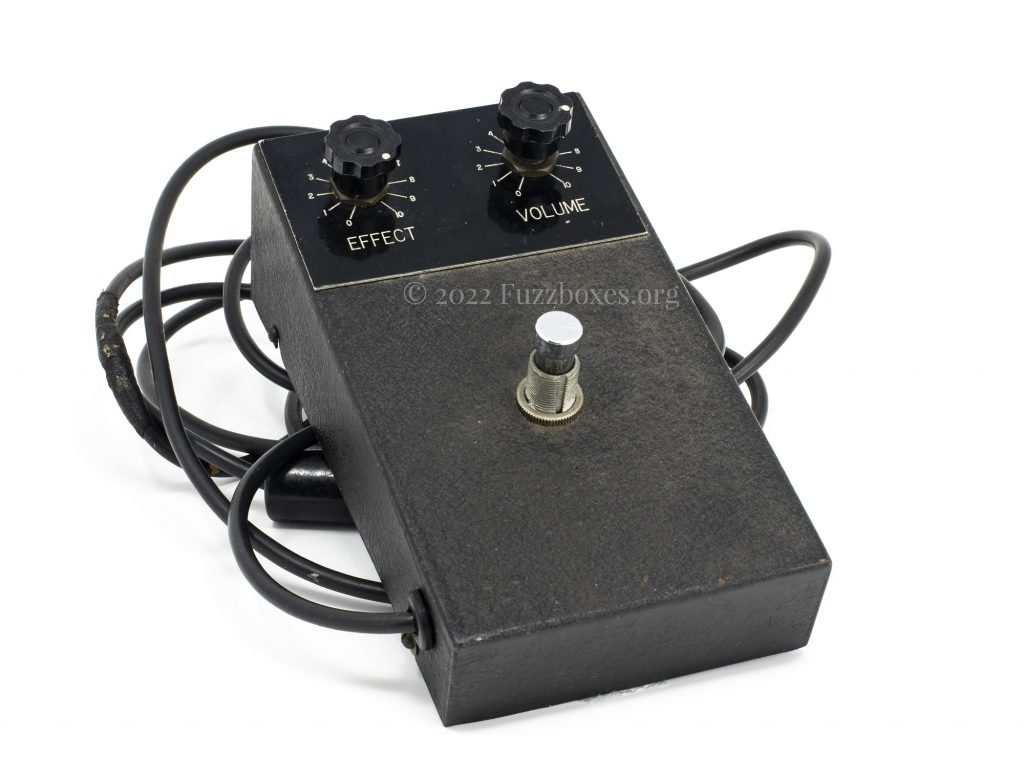
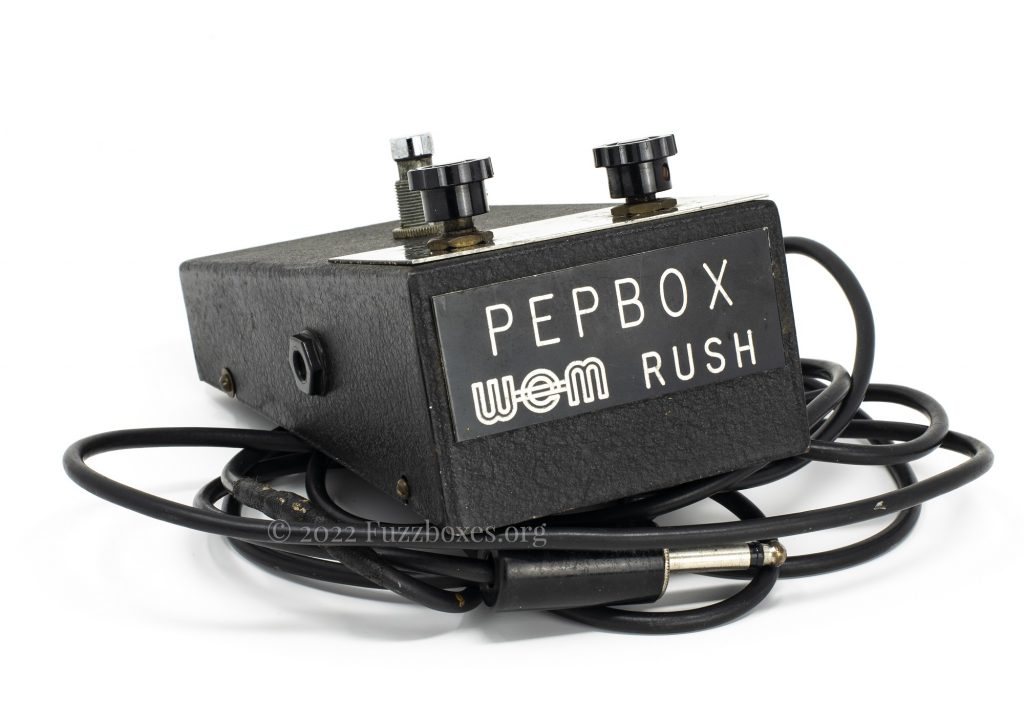
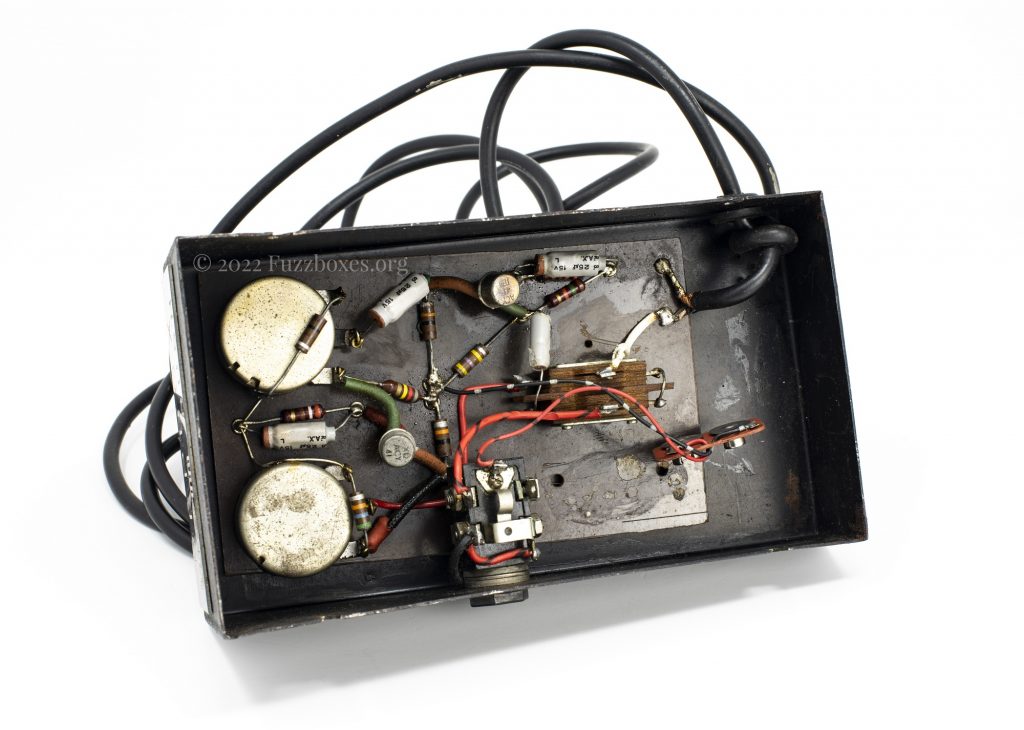
WEM Rush Pep Box pedals were initially built in wedge-shaped enclosures, made of folded steel. Some of the very earliest Pep Boxes were finished in black wrinkle paint, and featured engraved Traffolyte panels.
The pedal, photographed here, certainly predates the known silver ‘wedge-shaped’ Pep Boxes. It features a germanium-transistor circuit (using ACY41’s), and is built ‘point-to-point’ on an eyelet board. This early Pep Box belonged to Roger John Cameron, who was a guitarist & collector of guitar pedals, and who sadly passed away in January 2021.
Similar examples of this black Pep Box are reported to have been built, but without the engraved panels.5
Silver, with germanium transistors

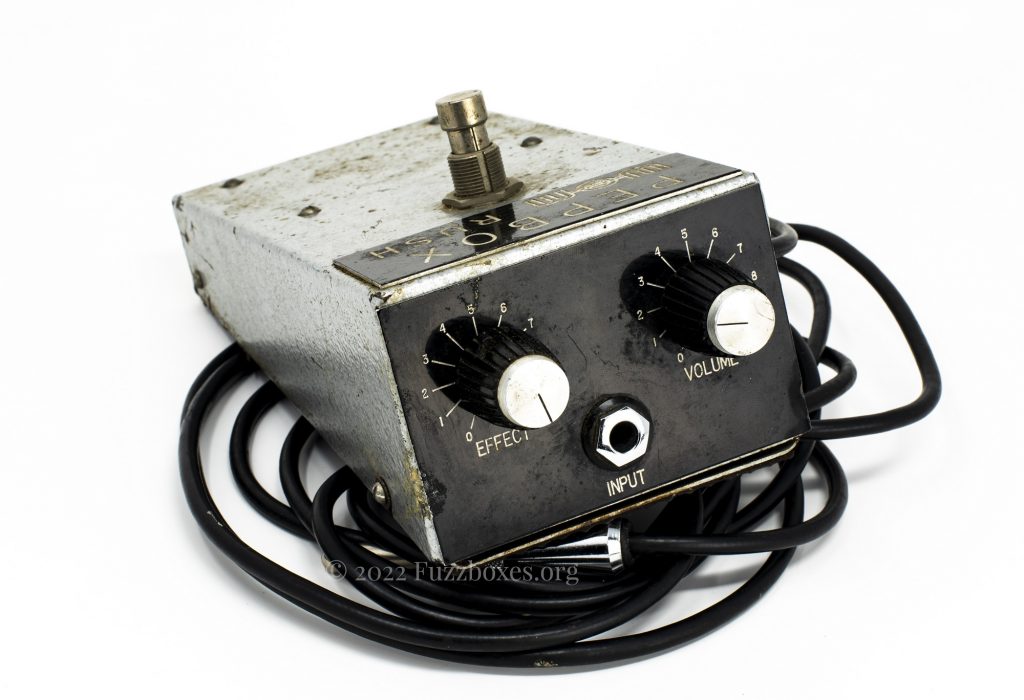
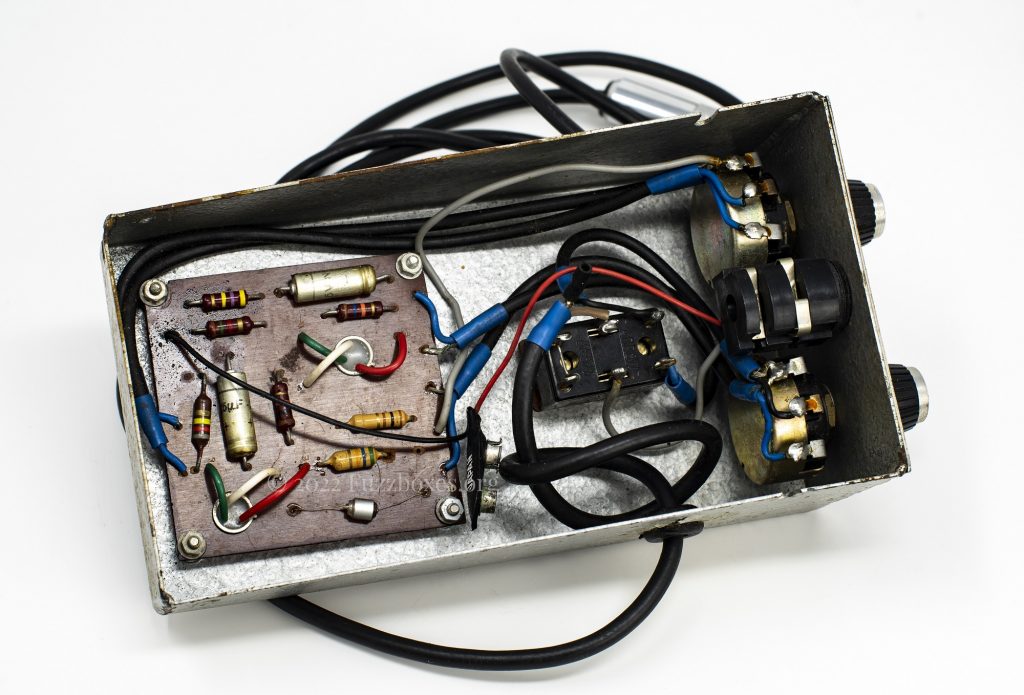
The pedal in the photograph below is the earliest known surviving version of the silver ‘wedge-shaped’ Pep Box. Similarly to the earlier black model, the early silver Pep Boxes also came with engraved Traffolyte panels and a germanium-transistor circuit. By the time that this silver pedal was built, however, the components in the Pep Boxes were being assembled on a printed circuit board.
This Pep Box was built during the period of around late 1965 to early 1966, and originally belonged to famed skiffle player, Chas McDevitt. McDevitt was an acquaintance of Pepe Rush’s, and ran a coffee bar next to Rush’s basement studio on Berwick Street. On a slight personal note, this silver germanium-transistor Pep Box is among my all-time favourites from within my collection.
In 2015, Pepe Rush reissued a series of silver wedge-shaped Pep Boxes based on this version of the circuit. Following Pepe’s death in 2018, his daughter (Lucy) continues to build silver Pep Boxes with this early design.
Silver, with silicon transistors
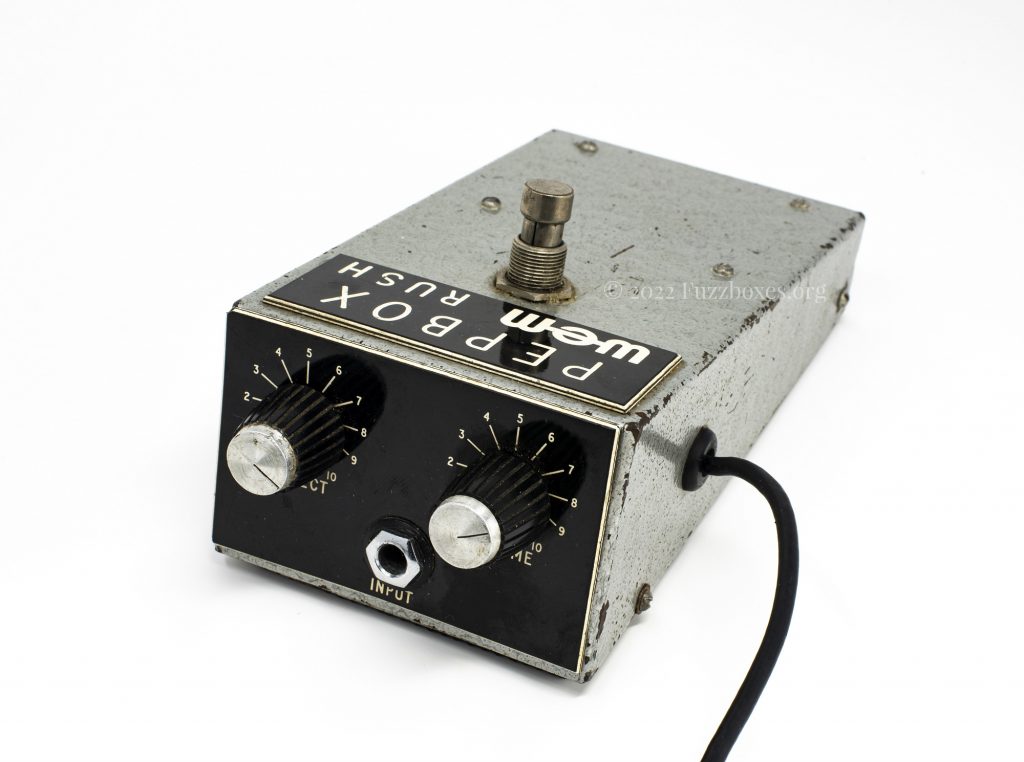
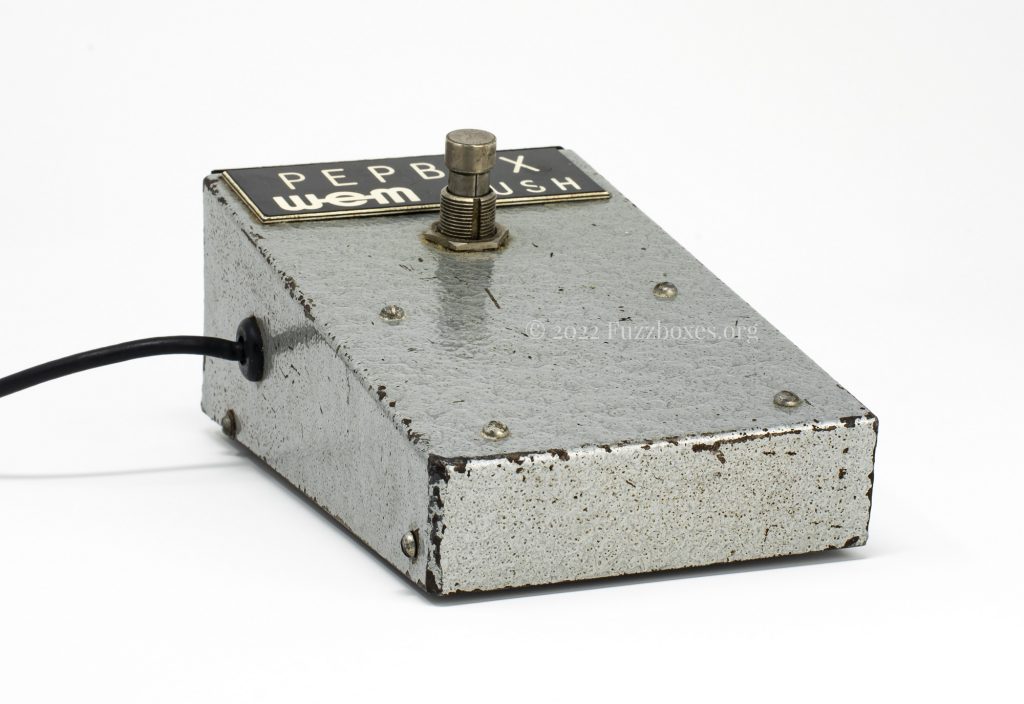

By around early 1966, the circuit of the Pep Box was updated to reflect the use of BC107-type silicon transistors in place of the earlier germanium type. Functionally, however, the Pep Box remained unchanged.
The first of the silicon-transistor Pep Boxes were built in the same silver, wedge-shaped boxes, as the earlier germanium version. By the time that the circuit was updated for silicon transistors, the Pep Boxes were also fitted with screen-printed Traffolyte panels, as opposed to the engraved panels.
Later, ‘long red’ Pep Boxes
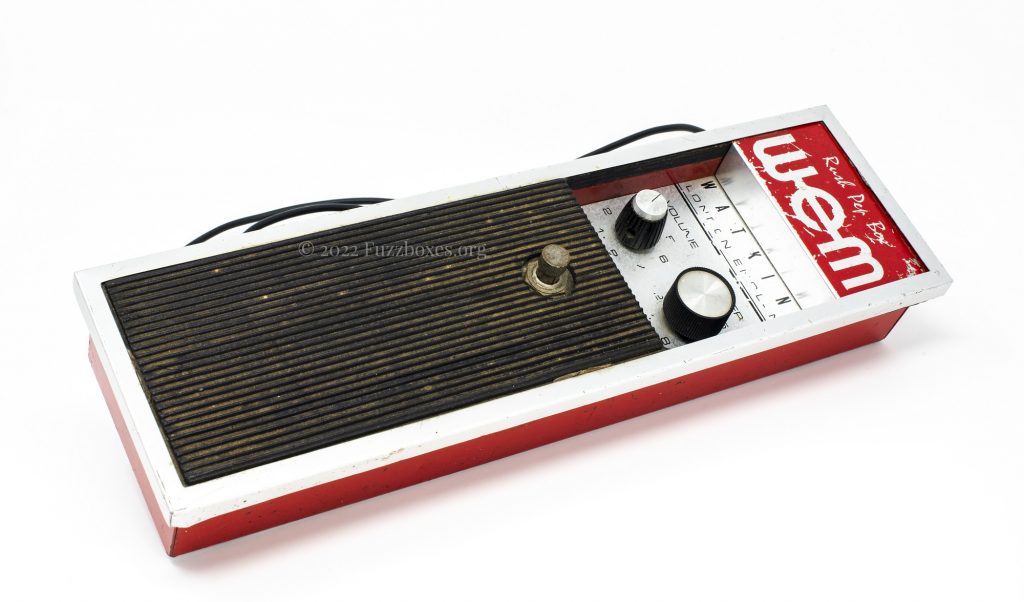

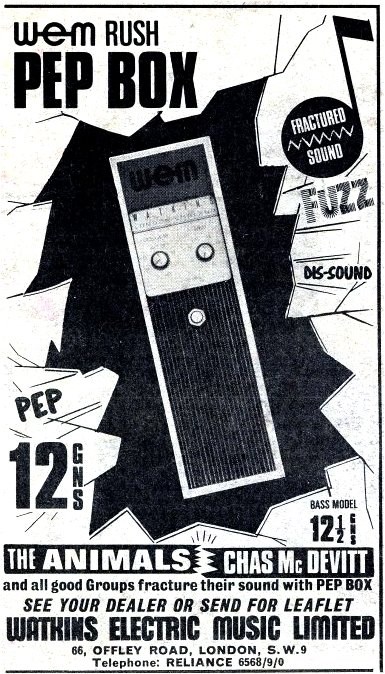
By July 1966,6 WEM were already producing their own enclosures for the Pep Box. The ‘long red’ WEM Rush Pep Box (as above) was pictured in product catalogues and in press advertisements. These distinctive housings were made from a combination of red-painted steel and wood, with the same metal trim that can be seen on WEM’s Powercat amplifiers. The same construction would later be used for WEM’s Project V fuzz box (which was otherwise unrelated to Pepe Rush).
These ‘long red’ Pep Boxes featured the same silicon-transistor circuit as the last of the silver wedge-shaped units. The selection of electronic components changed slightly, and a new printed circuit board design was made to accommodate the newer enclosure.
Whether or not Pepe Rush was still involved with the assembly of these pedals, following the change to the ‘long red’ enclosures, is unknown. At some point in the mid-1960s, WEM took over production of the Pep Box altogether, and Rush’s relationship with WEM reportedly soured. Pepe Rush recalled a conflict about WEM removing his name from the product,7 and indeed, some of the earliest Pep Boxes that were housed in the WEM-built, ‘long red’ enclosures, were missing the ‘Rush’ branding.
Most of these ‘long red’ Pep Boxes did, however, feature Rush’s name, and based on the date codes and the PCB designs of all of these ‘long red’ Pep Boxes, it actually looks more likely that WEM reverted to printing the Rush brand on their pedals, following only a brief period of claiming it as their own design.
An alternative version of events was provided by a friend & former colleague of Pepe’s, who recalled Pepe’s frustration that came as a result of WEM allegedly using “inferior” components for “their version” of the Pep Box.8
The exact relationship between Pepe Rush and Charlie Watkins will likely remain unknown.
Predating the Arbiter Fuzz Face, it is interesting to note that the ‘long red’ WEM Pep Boxes also featured a rubber mat around the footswitch.
Notable users

Most notably, John Lennon was photographed (above) with a Pep Box on at least three occasions in April 1966, during the recording sessions for the Beatles’ ‘Paperback writer’ & ‘Rain’. The non-typical placement of the output cable on the Beatles’ pedal, as well as its slightly oversized ‘WEM Rush’ panel, suggests that their pedal likely featured the germanium-transistor circuit. Whether the WEM Pep Box actually made it onto those, or any recordings at all, from the Beatles’ 1966 Revolver LP is unknown.
One early adopter of the Pep Box were the Artwoods. The group became acquainted with Pepe Rush following a chance encounter in the mid-1960s, and they ended up using an early version of the Pep Box on their songs, ‘I feel good’ and ‘Things get better’.9
Pepe Rush recalled delivering two Pep Boxes to Cecil Sharp House (English Folk Dance & Song Society) where the Shadows were rehearsing,10 but it is unknown whether the group ever actually recorded or performed with any of Rush’s pedals.
The Edgar Broughton band reputedly also made use of a WEM Pep Box.11
A WEM Pep Box may have briefly been used by King Crimson, as the model is specifically listed in the sleeve notes for a reissue of the group’s 1969 LP, In the court of the Crimson King. Robert Fripp also recalled playing with a “WEM fuzz box”, in a response to a reader’s enquiry about King Crimson’s ’21st Century Schizoid Man’.12 This testimony was printed several years prior to Fripp’s famous sessions with Brian Eno (where he may have experimented with Paul Rudolph’s/Eno’s WEM Project V), and so we can assume the ‘fuzz box’ to have been a Pep Box.
Pepe Rush was reportedly friendly with Eric Clapton,13 and Clapton provided a written endorsement of the WEM Rush Pep Box in response to a reader’s query in the press.14. Clapton does concede not actually having played the model, however.
Phil Chen was photographed playing bass guitar with Jimmy James & the Vagabonds, on Ready Steady Go in 1966, with a silver wedge-shaped Pep Box visible on the floor.15 When questioned more recently, however, Chen did not recall using any fuzz boxes for his bass guitar sound. The Danelectro Longhorn bass that he was photographed playing for that set reportedly belonged to John Entwistle, following a theft of the Vagabonds’ own instruments,16 and so it is possible — but unconfirmed — that the WEM Pep Box pictured on the floor may have also belonged to the Who.
The Animals featured regularly in WEM’s press advertisements for the Pep Box, and the group likely used a Pep Box of some sort on their 1966 single, ‘Don’t bring me down’. Hilton Valentine was also photographed (above) making adjustments to his Pep Box on stage during an Animals concert in Winston-Salem, NC, on July 26th, 1966. (Photo credit unknown)
Share your fuzz!
I welcome any comments, feedback, queries & corrections in relation to the Fuzzboxes.org project. Please get in touch via this contact form (or on the ‘contact‘ page).
Much of our understanding of the development of 1960s fuzz boxes comes from analysis of surviving pedals themselves, and so photos of pedals belonging to readers are particularly useful in furthering this research.
If you would like to contribute pictures of 1960s-era guitar effects to Fuzzboxes.org, then feel free to send in any pictures via the uploader below. Photos are greatly appreciated, and any submissions are not published on this website without advance agreement with the contributor.
